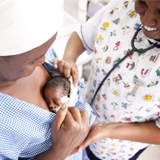
Thermal protection of the newborn is the series of measures taken at birth and during the first days of life to ensure that the baby does not become either too cold (hypothermia) or too hot (hyperthermia) and maintains a normal body temperature of 36.5-37.5°C (97.7-99.5°F). The newborn infant regulates body temperature much less efficiently than does an adult and loses heat more easily. The smaller and more premature the baby, the greater the risk. After birth, the wet newborn immediately starts losing heat and unless heat loss is prevented, hypothermia will develop. Hypothermia of the newborn occurs throughout the world and in all climates and is more common than believed. This condition is harmful to newborn babies, increasing the risk of illness and death. The temperature of the environment during delivery and the postnatal period has a significant effect on the risk to the newborn of developing hypothermia. In general, newborns need a much warmer environment than an adult. The smaller the newborn, the higher the temperature needs to be. The "warm chain" is a set of ten interlinked procedures carried out at birth and during the following hours and days which will minimize the likelihood of hypothermia in all newborns. The room where the birth occurs must be warm (at least 25°C/77°F) and free from draughts. At birth, the newborn should be immediately dried and covered, before the cord is cut. While it is being dried, it should be on a warm surface such as the mother’s chest or abdomen (skin-to-skin contact). Skin-to-skin contact with the mother is the best way of keeping the baby warm. If this is not possible, alternative means of preventing heat loss and providing warmth — such as wrapping the newborn baby and putting it in a warm room or under a radiant heater — will be necessary. Bathing and weighing the baby should be postponed.
Breast-feeding should start within one hour of delivery. This will provide the baby
with calories to produce body heat. In the days following birth, hypothermia can be prevented by keeping the baby and mother together (rooming-in), by breast-feeding as long and as often as the baby wants, and by dressing the baby appropriately for the environmental temperature. Low birth weight or sick newborns are most vulnerable to hypothermia. Methods to keep these high-risk babies warm include kangaroo-mother care (round-the-clock skin-to-skin contact), "warm rooms", heated water-filled mattresses, radiant heaters, and incubators. A newborn baby placed in a heating device or a "warm room" should be taken out periodically for skin-to-skin contact with the mother and for breast-feeding. The body temperature of the baby should be monitored frequently. Thermal protection of the newborn: 2 WHO/RHT/MSM/97.2 Hypothermia occurs when the newborn’s temperature drops below 36.5°C (97.7°F): 36-36.5°C (96.8-97.7°F) is mild hypothermia (cold stress); 32-36°C (89.6-96.8°F) is
moderate hypothermia; less than 32°C (89.6°F) is severe hypothermia. Hypothermic newborns must be rewarmed as quickly as possible by skin-to-skin contact or any of the above-mentioned methods, depending on the availability of staff and equipment and the severity of the hypothermia.
Hyperthermia is as dangerous to the newborn as hypothermia and can be prevented by dressing the baby appropriately for the environmental temperature and not placing it too close to a source of heat or in full sunlight. In particular, incubators should not be exposed to direct sunlight, and the temperature inside the device as well as the baby’s own temperature should be monitored frequently. The information presented in this guide provides a basis on which managers and health care providers can develop their own strategies and procedures for thermal protection and management of hypothermia and hyperthermia of newborn babies.
Please download the resource to view the full article.